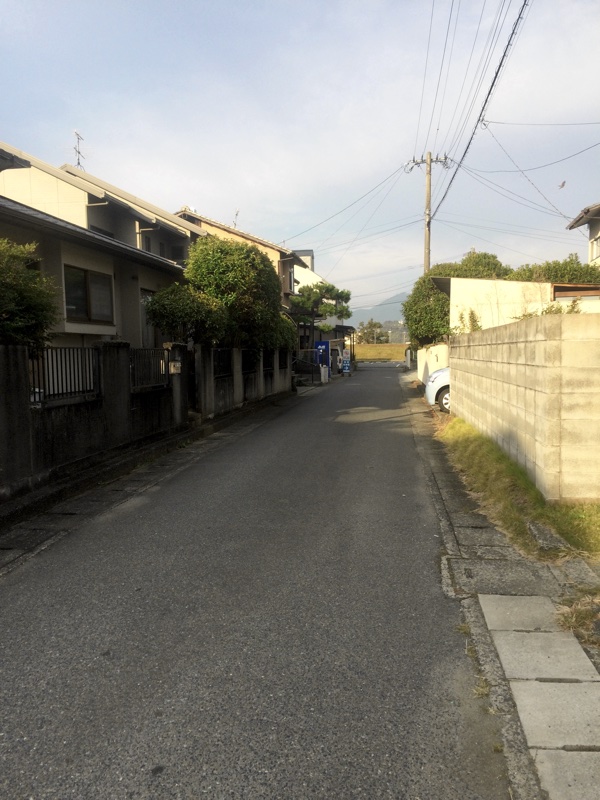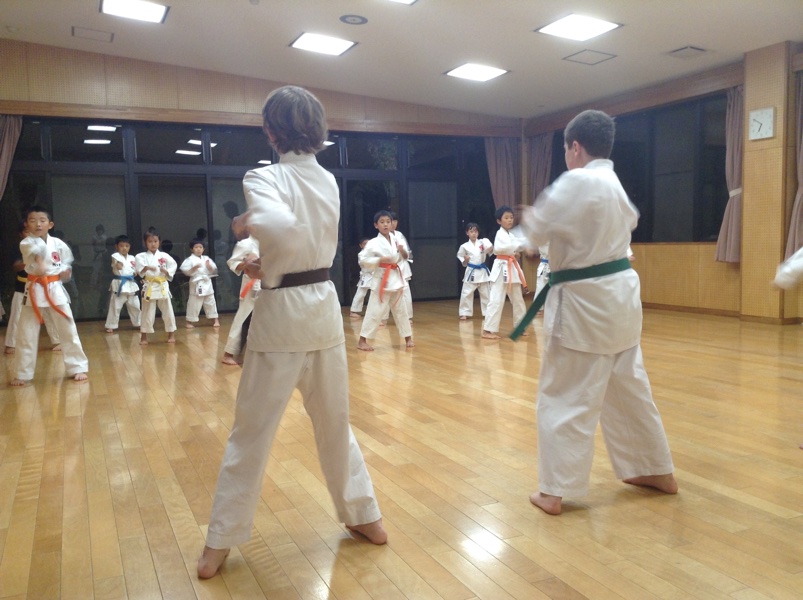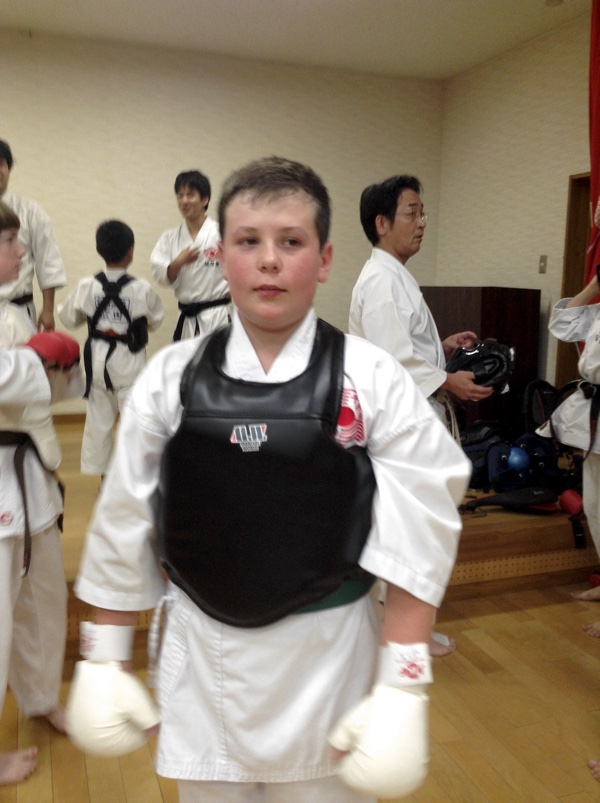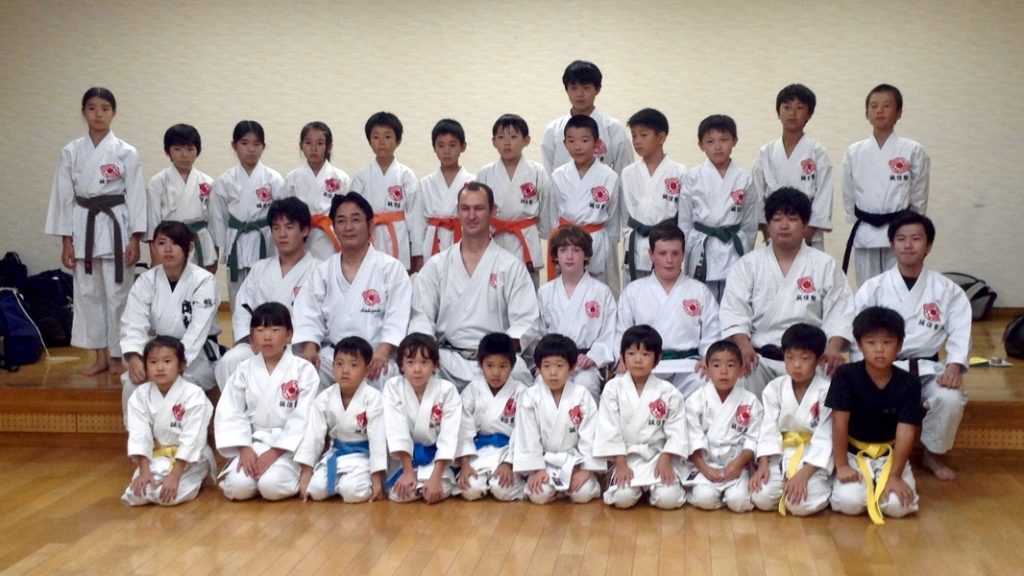Getting settled in, so it’s time for morning training again with Soke Sensei. As usual training started at 6:30am with 30 minutes meditation in seiza. This morning Tanaka Sensei & Todd Sensei both joined us for training. I love the energy they both bring into the dojo, again a bit of a trip down memory lane for me. It’s been quite a few years since we have all been in the dojo together like this and now I get to share it with two of my young students.
It wasn’t a high pace class, but still that same familiar routine. I don’t know how many times I’ve done that same routine over the years, yet there is still always something more to find. I love the way Soke Sensei has this way of having everyone do the same thing and yet the training is completely personalised with an individual focus for everyone within the same routine. It’s not unusual for two people to come away from the same session with completely different things learned.
After training, Soke Sensei asked Tanaka Sensei to offer a few words of advice as I worked towards my final preparations towards my godan grading scheduled for Monday (3 days away). As everyone left the dojo I performed my kusanku kata and Tanaka Sensei shared a few things that he thought could be improved a little. I love that, even after more than 30 years of training, there’s still more. There’s always more. With each repetition of the kata, it got a little better. We continued on for about another 20 minutes after the class had finished.
After training, breakfast, washing, catch up on blog posts and a little bit of a relax.
Then I get the call out from Minowa Sensei downstairs “Phillips Sensei”, “hai”, I answered and went downstairs to see what required my attention.
Masuda Sensei had dropped in for a quick introduction. It had been planned that we would visit his dojo tonight.
Introductions and a quick chat done, then I went back upstairs. A little while later…. “Phillips Sensei”, “hai”, I answered again and went downstairs.
Sakaguchi Sensei had dropped in to the dojo. He is one of only a handful of the old masters left who trained directly under O Sensei. Sakaguchi Sensei is a small, thin man, but he’s tough. He loves kumite and he loves causing pain.
When we spoke and he invited me to visit his dojo next week, he said, “I’m in my 80’s now, I’m getting old, this might be the last chance you get to visit my dojo while I’m still around.” He’s very conscious of the fact that he’s getting older and many of the other sensei of his generation have already passed away, so I think he really wants to share what he can and make an impression on the current generation of people coming through such as myself. So, of course, I didn’t want to miss this opportunity and happily accepted the invitation.
Washing all done, we set out on the local train to Kami-Kumamoto Station and changed to a tram to head into Suizenji garden. It’s a bit of a round about way to get there, but it’s also good because it’s a good way to see a bit more of the back streets of Kumamoto. And you get to see things that you wouldn’t otherwise see.
In the course of our small adventure, we started to compare notes on things that are a bit different here in Kumamoto as compared to the Sunshine Coast. One of the most obvious things that comes to mind is that everything is just so old. The buildings, the infrastructure, even the town planning seems to be very organic. There are overhead powerlines and phone lines everywhere. In many parts of the Sunshine Coast, this is quite uncommon now, with everything underground.
Having just built a new house this year, we opted to buy one of the larger blocks. Over the last few decades lot sizes have been shrinking in Australia. When I was in primary school, 1/4 acre blocks were very common, but now, the most common size in new estates in Australia is around 450sqm. Even on these 450sqm blocks in Australia, it’s not uncommon to see houses of 200+sqm. This is very different to Kumamoto, compared to Australia, the houses are so close together, yards are very small and in most residential areas there are no footpaths or nature strips. Houses are built right up onto the street. And the streets are narrow.
Here are a couple of photos of the street where the sohonbu is located, looking in different direction, which gives a bit of an indication of what a typical street looks like in Kumamoto.


The built landscape is not just houses, there’s still a lot of green around. There is still a lot of parks and natural bushland and agriculture. But it really is amazing how much of the land is utilised. The countryside is very hilly. Kumamoto City itself is fairly flat, but there are mountains all around. But a lot of this land has been terraced to all for buildings to be constructed and farming.
Suizenji garden is about 7-8 minutes by tram from the CBD, so it didn’t really take long to get there. The venue for next year’s Soke Cup is very close to Suizenji garden which will be really handy for both accommodation and public transport. Personally I think this will be a good location for a Soke Cup tournament. Not quite as good for the locals, as I’ve heard parking is not that great, but definitely good for international visitors.

A short walk from the tram stop, I always seem to get lost somehow… A sit down lunch at a restaurant near the entrance to Suizenji garden, then into garden. It’s an amazing place, beautifully manicured lawns, sculpted trees, a complete escape from the rat race of the city. I’m not even going to try to describe how amazing it is, just look at the small selection of photos below (click to enlarge).
After the taking our time to take a relaxing wander around Suizenji garden we did a little gift shopping slowly found our way back to the sohonbu by tram and light rail. Time for a short rest Masuda Sensei’s Dojo.
Masuda Sensei’s dojo is just a short drive from the sohonbu. Based right next to one of the local driving schools in a community hall. When we arrived at the dojo there were already a few students there at the dojo. At first most of the students were primary school aged, but as the class went on more and more kids, teenagers and young adults came. Most dojos in Japan seem to have either one or two classes in the evening.
Usually classes start quite late compared to what our students are used to in Australia. Our classes are much shorter in duration (40-60 minutes in duration) and broken up by age and rank. Every afternoon at home we start not long after school has finished and our last class ends by 8pm. This gives us time to do 4-5 classes every afternoon.
By contrast, most classes in Japan are either 90 minutes or 2 hours. Normal school hours are 8:30am – 4:00pm. And most students are involved in some kind of school based club after that until around 6pm (or later). As a result of these differences it’s not unusual for students to be coming into class well after the classes start in Japan.
At Masuda Sensei’s dojo in particular whenever another student entered the dojo they would bow at the dojo call out “konban wa” (good evening) and everyone would stop what they were doing and echo back the greeting. Although it’s a bit of a distraction, compared to what we’re used to, this kind of acknowledgement helps to create a strong sense of belonging to the group.
At first Bailey and Luc were the most senior ranked students in the group, so they took that place in line accordingly. But as time went on more of the black belt teens and young adults entered the dojo.
Masuda Sensei lead the warm up and kihons and a little kata. It was great to watch Bailey & Luc, you could see that they were familiar with everything, yet at the same time the culture of the class and the way things were presented was different enough to keep them on edge a little, not quite sure what was coming next.

After a quick run through some kata, we broke up into groups. A few of the local black belts took the beginners. I took a group of orange and green belts (which would be equivalent to blue and purple belts in Australia) and focussed on Seisan kata. And Masuda Sensei worked with Baiely and Luc on Seisan and Niseishi Dai.

For me it was interesting to see how confident all of the kids at this level are with these kata. In Japan if you compete in tournaments, you must do kata Shihohai and above. Only the pre-school aged kids get to do kihon kata in tournaments. And the level of participation in tournaments is much greater in Japan. Normally around 70 percent of students participate in tournaments. There is a very strong competition culture. In Queensland dojos, we usually only get about 25-30 percent of students participating in tournaments.
I was looking out of the corner of my eye watching what Bailey and Luc were learning, and Masuda Sensei had picked up on a few things that we don’t really focus on so much back home. And I had done the same with his students. This is one of the things I like about this kind of opportunity. We each get to learn about things from a different perspective about what we think is important.
After kata we moved on to kumite. Neither Bailey nor Luc had brought bogu or gloves so they had to wear different equipment than they are used to. The drills they did were not so different to what they’re used to, until we got to time for matches. In Chito-Ryu in Japan, all kids, not matter their age wear head gear in tournaments. Because they’ve been doing it for so long this way they have grown a culture of controlled contact, both in the students and in the teachers and referees.


In Australia, we find that as soon as the head gear goes on students see it as an invitation to try and punch their opponent as hard as they can. Particularly for juniors, this is not such a good thing, so about 10 years ago, we opted not to allow head techniques in tournaments for young juniors at all.
A few years ago in QLD, we started to reintroduce attacks to the head for young juniors (U/14 Yrs), but no head gear is worn and no contact is allowed. We have found that for students heading towards competing at the Soke Cup, this provides a much better stepping stone than banning all head techniques altogether.
Each of he different sets of rules has both good and bad points, but it’s quite a big process to change any culture, so it’s still a work in progress.
Anyway, back to the class… Time for kumite matches, Masuda Sensei asked if Bailey and Luc would like to do a match with head gear. This was a first for both of them and they stepped up well. The thing that I found really interesting was that on both sides no one really knew what to do with their opponents, because their fighting style is so different.
Australian fighting style v’s Japanese fighting style is quite different. Bailey is quite quick but still developing confidence to really sink his techniques into the target at the correct distance. Luc has quite a big telegraph that we’re working on removing, but he’s still quite quick. As a result he is quite a defensive fighter. They were both very surprised that it “didn’t really hurt” because the level of contact is so well controlled. The biggest thing that they’ll both need to get used to though is how restrictive the vision becomes in headgear. The thing about that though, your opponent has the same issue.
Although different from what we’re used to, there was still a good strong family vibe in the dojo. There were quite a few parents who watched they class and the kids were all quite lively and friendly. Another good fun night of training.

After training, Masuda Sensei dropped us back to the sohonbu. A little bit of an earlier finish than we’d had most other nights. But the early finish was welcome as I can see the early mornings and late finishes starting to catch up to Bailey and Luc a bit.
What makes it even easier is there is no early morning start tomorrow. Being Saturday, our class starts at 10am. A chance for a much needed sleep-in.



0 comments